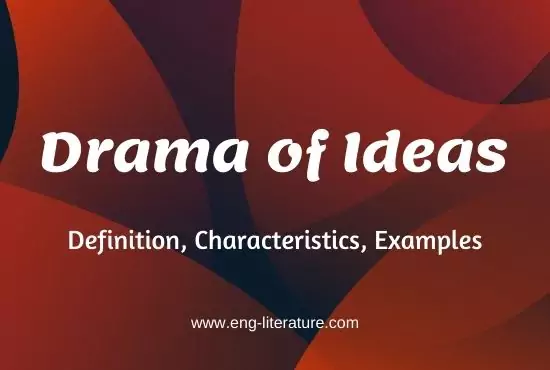Drama of Ideas Definition
Problem play and the Drama of Ideas both are considered as two names of the same dramatic genre and critics may argue on this fact that there is no distinction between the drama of ideas and the problem play or the propaganda play. But drama of ideas is a type of drama in which the pleasure and interest evolved out of drama are almost entirely intellectual and emotions are not as much affected as are after seeing tragedy and comedy.
On one hand, the problem play treats a particular social or moral problem which compels people to think intelligently about it and ultimately leaves the man in dilemma. It appeals to vigorous hearts and thoughtful minds and thus contributes in progressing them. On the other hand, the excitement arose out of Drama of Ideas lies in speculating events and concentrating upon their outcome in future life with full spiritual, logical and philosophic attitude. Drama of Ideas sets the mass talking and puts various points of views and interestingly, it is another thing that at times, some of them come in the form of unusual happening.
Drama of Ideas Writers
Henrik Ibsen, George Bernard Shaw and Granville Barker were the chief exponents of drama of ideas. The drama of ideas are the vehicles for the transportation of ideas, howsoever, propagandizing they may be. Many playwrights of ideas wanted to cast their ideas through discussions. To bring out the clear points of difference between the Problem Play and The Drama of ideas, we will have to make out the difference between the plays of Galsworthy and G. B. Shaw. John Galsworthy states his ideas through the actions and characters of his plays as in the Frome’s court speech in Justice stating his moral didactically, while G. B. Shaw states his ideas in verbal form.
| Problem Play | Drama of Ideas |
| Through Action and Character | Through Argument and Speech |
Characteristics of Drama of Ideas
The problems arose in Drama of Ideas are not such so as to be tried to be solved in routine life and there is no need to be implied and we try to meditate upon the issues which are raised in the drama The most productive reason of clash in these drama of ideas are love with its connected phrases like sex, marriage, free love, the fallen women and the like perversions. Following list will be helpful for students in remembering this theme in drama of ideas.
Drama of Ideas Example
G. B. Shaw has been broadly applauded as the precursor of the New Drama in England, which is also known as the drama of ideas. Shaw highly respects the importance of ideas, and uses ideas as the basis of dramatic conflicts of his plays. Shaw’s plays are mostly battles of ideas and words, characterized by endless talking and discussions Shaw is against ‘art for art’s sake’, and emphasizes on the value and social function of the drama. He advocates that drama should be the factory of production of and the reminder of the conscience. George Bernard Shaw’s Back to Methusaleh, Man and Superman and The Apple Cart are the finest examples of drama of ideas while Widowers’ House and Mrs. Farren Profession are real problem plays as they concentrates upon some social issues and we have to think a better solution of the rampant social problem.
On the other hand, Somerset Maugham’s Sheppey can obviously be called a drama of ideas because here in the story, a man suddenly becomes wealthy and interprets Christianity in a more literal way than is usually done. The Circle, the second play of Somerset Maugham has also some of such kind of interest, though it is somewhat unsatisfactory form and is a light comedy treatment of a theme that is tragic or approximate to it.
Sutton Vane‘s Outward Bond can be called a less ingenious example of the drama of ideas. In this age of changing values and morals, the form of problem play is very popular. We cannot trace out earlier examples of this kind because they are too difficult to trace. But still, we cannot deny this fact that the dramas of
Shakespeare had considerable elements of the drama of ideas like Coriolanus and Troilus and Cressida and Christopher Marlowe’s Dr. Faustus. Dramatists like Strindberg, Wilde, Pirandello, Sartre, Stoppard and philosophers such as Nietzsche, Gilles Deleuze, Alain Badiou, and Martha Nussbaum are notable names in field of Drama of Ideas. In recent times, the theme of these drama of ideas is not chosen for their own sake as it was done in the past, but these themes are chosen for they offer striking characters, dramatic conflicts and a better theatrical situation for the drama as a way of flattering the spectators with its already established prejudices.
5 Best Drama of Ideas in English Literature
- A Play of Love by John Heywood
- Arms and the Man by G. B. Shaw
- Getting Married by G.B. Shaw
- Strange Interlude by O’Neill
- The Platonic Lovers by Sir William Da’venant
- The Honest Whore by Thomas Dekker
Conclusion
This is rarely seen that such themes are used in drama of ideas to challenge the old established norms of society. The way, it compels the spectators to think and rethink on the issue in drama, has become the chief reason for its inevitable place in the modern theater.

Hello, Viewers! Besides being the Founder and Owner of this website, I am a Government Officer. As a hardcore literary lover, I am pursuing my dream by writing notes and articles related to Literature. Drop me a line anytime, whether it’s about any queries or demands or just to share your well-being. I’d love to hear from you. Thanks for stopping by!

Please put the answer of the drama of ideas in Modern Theatre.
Ok I will… Stay tune
What are the themes of the drama of ideas?
Good interpretation